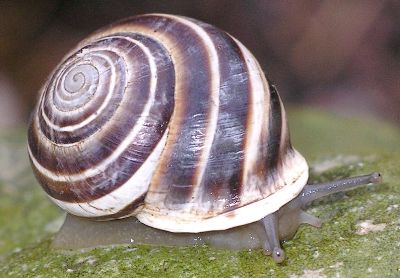by Valerie
July, 2004Banded Garden Snail
Despite our rather hot and dry climate, there are a number of terrestrial snails that inhabit our gardens. The biggest and prettiest is the banded garden snail (Otala lactea). This mollusk is not native, but has been imported from Europe, both as food and with plants. It can now be found in scattered populations throughout much of the U.S. I've sometimes found large collections of the dead, bleached shells of these snails in wooded areas around Austin and Waco, so they can obviously survive our climate and even thrive, at least long enough to build up sizeable populations. Often, we see lighter colored live banded garden snails while walking in our neighborhood. The individual in the photo was found by Larry on a walk and he brought it home so I could photograph it. I then released the snail near our back fence and it crawled on its merry way. Over the next few months, I saw the same snail living along the fence, sometimes in the rocks and sometimes on the garden tools stored back there. During dry times, the snail would seal itself in its shell to retain moisture, a habit shared with all the other snails in our area. Banded garden snails are highly variable in their coloration. Although not visible in the above photo, the underside of the shell lip is dark brown and this is a pretty good, but not infallible, way to identify this species. The snails may be banded or plain and may be pinkish, yellowish, tan, or brown. I've rarely seen any shells locally with the intense brown bands that make this individual so attractive. Snails, and the closely related slugs, are generally considered to be garden pests and known to eat tender young plants. We've found that in our yard, slugs do most of the damage to seedlings so I feel no compulsion to control the snails. Considering that our "pet" snail spent its time in an area with little vegetation, I suspect that it was eating dead plant material or other organic debris. Snails often scour the smooth bark of trees or damp rocks, presumably eating algae or fungus. This species of snail is large enough, at just over an inch in diameter, to be considered edible. While it is not one of the main species raised for food, it is occasionally eaten. There is a belief that snails with stripes do not taste as good as those with plain shells. |